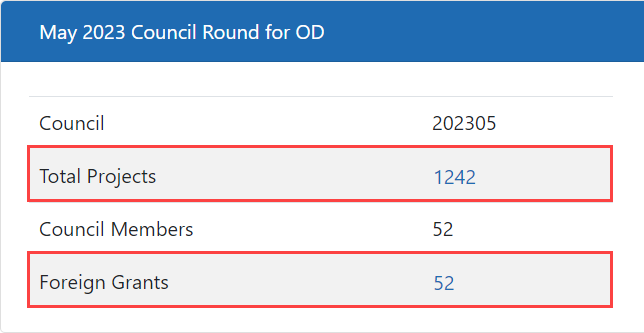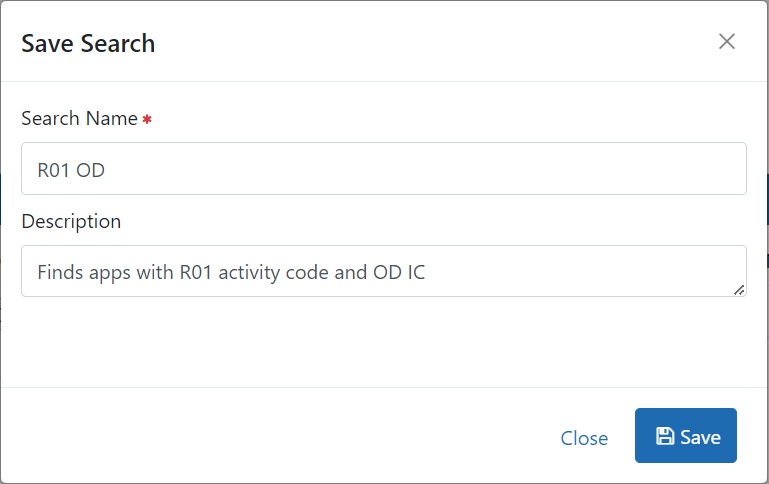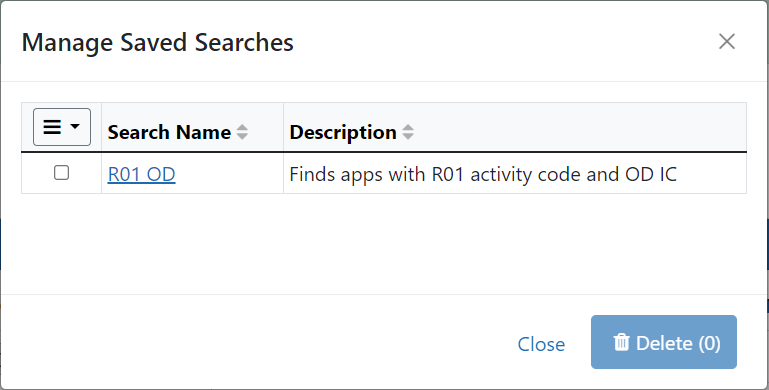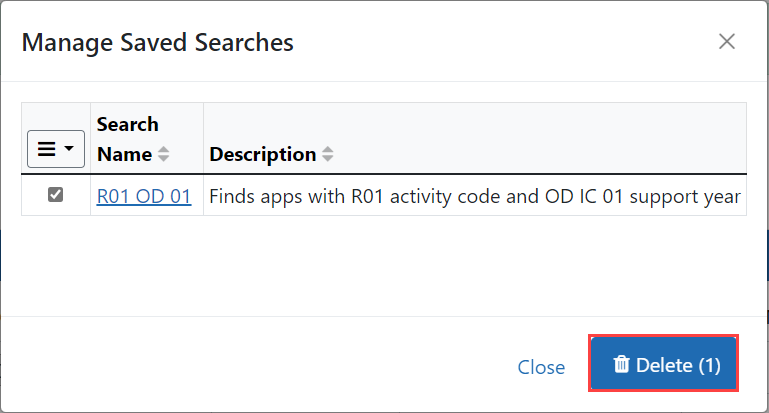Searching for Applications
ECB allows you to search for applications in two ways: from the Home screen and from the Search screen.
Searching for applications from the Home screen
Search using the Quick Search field

The Quick Search field, located in the upper-right corner of the screen, allows you to search for an application by grant number, PI name, or accession number.
| 1. | Enter the grant number, PI name, or accession number in the Quick Search field. |
TIP: If you are searching by accession number, you can search for up to ten applications at a time. Use a comma (,) to separate multiple values.
| 2. | Click the Search button. The Project Search Results screen is displayed. |
| 3. | To add the application to a council, click the  three-dot ellipsis button and select Add Council, select the appropriate option from the Council Rounds drop-down, and click the Save button. The application is added to the council. three-dot ellipsis button and select Add Council, select the appropriate option from the Council Rounds drop-down, and click the Save button. The application is added to the council. |
| 4. | To remove the application from a council, click the three-dot ellipsis button and select Remove Council, then click the Yes button. The application is removed from the council. |
Search using the quick links in the council round cards

The links in the current council round pane on the Home screen provide you with two options: view all projects and view only foreign grants.
Displaying all projects
| 1. | In the current council round pane, click the hyperlinked number for Total Projects. |
The Project Search Results screen is displayed. It contains an unfiltered list of all projects for the current council round for your assigned IC.
Displaying Foreign Grants
| 1. | In the current council round pane, click the hyperlinked number for Foreign Grants. |
The Project Search Results screen is displayed. It contains a filtered list of all foreign grants for the current council round for your assigned IC.
Searching for applications from the Search screen
| 1. | Click the Search tab in the ECB menu at the top of the screen. |

The Search screen is displayed.
Selecting search criteria
There are four panes of search criteria:
The Council Rounds drop-down at the top of the screen limits the page to the selected council round. Although it defaults to the current council round, you may select previous and next rounds.
NOTE: If you select a previous council round, the screen content will be read-only.
Council rounds roll over on the following dates:
|
Council |
Rollover date |
|---|---|
|
January Council |
November 1st |
|
May Council |
March 1st |
|
August/October Council |
July 1st |
Project Type searches for one or more project types. Enter a type, then select it from the drop-down list of potential matches. Note that you can select the Exclude checkbox to include all project types except the specified type(s).
Activity Code searches for one or more activity codes. Enter a code, then select it from the drop-down list of potential matches. Note that you can select the Exclude checkbox to include all activity codes except the specified code(s).
ICs searches for one or more ICs. Enter the IC abbreviation, then select it from the drop-down list of potential matches.
Serial Number searches for the six-digit number assigned within an IC.
Support Year searches for the two-digit number indicating the segment or budget period of a project.
Suffix searches for the suffix appended to an application (e.g., A1 is a resubmission).
Opportunity Number(s) searches for the funding opportunity number assigned to a grant. Enter an opportunity number or part of an opportunity number using % as a wildcard, then press Enter to add it to the search criteria. Repeat to add multiple opportunity numbers. Note that you can select the Exclude checkbox to include all opportunities except the specified one(s).
Primary/Secondary Projects searches for primary projects, secondary projects, or both. Click the drop-down to select the desired options.
Percentile allows you to set a minimum value, maximum value, or both for the Percentile score in council review. Note that if an application does not have a Percentile score, it will be filtered out if any criteria are entered here.
Priority Score allows you to set a minimum value, maximum value, or both for the Priority score in council review. Note that if an application does not have a Priority score, it will be filtered out if any criteria are entered here.
Direct Costs Range allows you to set a minimum value, maximum value, or both for the direct cost per period in the budget detail.
Total Cost - Special Council Review Threshold allows you to set a limit for the total cost threshold. You must select the Include checkbox to use this criterion.
Direct Cost - Special Council Review Threshold allows you to set a limit for the direct cost threshold. You must select the Include checkbox to use this criterion.
Include Program Class Code(s) searches for applications that include the specified class code(s). Use an underscore (_) for a wildcard representing one character and a percent sign (%) for a wildcard representing multiple characters. If you wish to include multiple criteria, separate them with a comma (,). For more information on program class codes, visit https://partners.niehs.nih.gov/program.
Exclude Program Class Code(s) searches for applications that do not include the specified class code(s). Use an underscore (_) for a wildcard representing one character and a percent sign (%) for a wildcard representing multiple characters. If you wish to include multiple criteria, separate them with a comma (,). For more information on program class codes, visit https://partners.niehs.nih.gov/program.
Program Class Code breaks out the code into eight separate search fields, one for each element of the program class code. For more information on program class codes, visit https://partners.niehs.nih.gov/program.
Application ID's searches for applications with the specified application ID(s). If you wish to include multiple criteria, separate them with a comma (,).
Project Status searches for applications in the specified status(es). Click the drop-down and select the checkboxes for each status you wish to include. You can use the search field at the top of the drop-down to enter the two-digit code to find a status more quickly.
New/Early Stage Applications searches within applications marked as New/ESI applications to find all new investigator applications, all early stage investigator eligible applications, or all early stage investigator ineligible applications.
New/Early Stage Investigator searches within applications where the PI is a New or ES Investigator for all new and early stage investigators, only early stage investigators, or only new investigators. Note that an application can have a New/ESI PI, but not be marked as a New/ESI application.
Institution Name searches for applications where the primary investigator is affiliated with the specified institution. Note that this performs a contains search and wildcards are not necessary.
PI Last Name searches for applications based on the PI's last name.
PI First Name searches for applications based on the PI's first name.
Multi-PI Projects searches for applications marked as MPI.
Key Personnel Last Name searches for applications based on the key personnel's last name(s).
Key Personnel First Name searches for applications based on the key personnel's first name(s).
State searches for applications in the specified state(s) if US is selected on the application. Click the drop-down and select the checkboxes for each state you wish to include. You can use the search field at the top of the drop-down to enter the state name to find a state more quickly. Note that this field is disabled if a non-US state is selected.
Country searches for applications in the specified country. Click the drop-down and select the checkbox for the country. You can enter a country name in the search field at the top of the drop-down to find a country more quickly. Note that this field can be used in conjunction with the Include FACTS Sites and/or Include Performance Sites checkboxes.
Iinclude FACTS Sites includes Foreign Award and Component Tracking System (FACTS) sites in the Country search.
Include Performance Sites includes performance sites in the Country search.
Study Sections fields search for the specified criteria.
PO Last Name searches for applications based on the PO's last name(s).
PO First Name searches for applications based on the PO's first name(s).
Scores Released Since searches for applications with scores released since the specified date (process stage code 103). Enter the date in MM/DD/YYYY format or use the calendar button to select the date.
Summary Statement Release Status searches for applications that have or have not released a summary statement.
Summary Statement Release Date Range allows you to set a start date, end date, or both for the time frame the summary statement was released.
Trans NIH Initiatives searches for applications based on the selected initiative(s). Click the drop-down and select the checkboxes for each initiative you wish to include. You can use the search field at the top of the drop-down to enter the state name to find an initiative more quickly. Note that you can select the Exclude checkbox to include all applications except the ones based on the specified initiative(s).
Applications Assigned To searches for applications with no assignments or assigned to the selected council member(s). Click the drop-down and select the checkboxes for the appropriate council member(s).
Council Member Conflicts for searches for applications with no conflicts or with which the selected council member(s) have a conflict . Click the drop-down and select the checkbox(es) for the appropriate council member(s).
NOTE: When a council member has a conflict with one application, a conflict is automatically added to all applications for that FOA.
Staff Member Conflicts for searches for applications with no conflicts or with which the selected staff member(s) have a conflict . Click the drop-down and select the checkbox(es) for the appropriate staff member(s).
NOTE: When a staff member has a conflict with one application, a conflict is automatically added to all applications for that FOA.
Saved Lists searches for applications assigned to a saved list. Click the drop-down and select the checkboxes for the appropriate saved list(s). Note that you can select the Exclude checkbox to include all applications except the ones on the specified list(s).
Early concurrence Panels searches for applications assigned to an early concurrence panel. Click the drop-down and select the checkboxes for the appropriate EC panel(s). Note that you can select the Exclude checkbox to include all applications except the ones on the specified EC panel(s).
AIDS
Animal Subject Concerns
Biohazard concerns
Children concerns
Clinical Trials (PI-Identified)
Foreign Grants
Gender Concerns
Human Subject Concerns
Minority Concerns
Phase 3 Clinical Trials
Selecting the Satisfy All Criteria radio button will perform an AND search, requiring applications to meet every specified criteria in the Special Selects Section.
Selecting the Satisfy Any Criteria radio button will perform an OR search, requiring applications to meet any specified criteria in the Special Selects Section.
Click the All Yes button to select Yes for every criterion in the Special Selects Section.
Click the All No button to select No for every criterion in the Special Selects Section.
Click the Clear button to remove every selected criterion in the Special Selects Section.
Running a search
Once you have selected the appropriate criteria, you are ready to run the search.
| 1. | Click the Search button in the lower-right corner of the screen to run the search with the selected criteria. |
The Project Search Result screen is displayed.
Modifying a search
If your search did not find the expected results, you may need to modify your search criteria.
| 1. | Click the Go back link in the upper-right corner of the screen. |
You are returned to the Search screen and search criteria you selected are displayed.
| 2. | Modify the search criteria as desired. |
| 3. | Click the Search button to rerun the search. |
Saving a search
If you need to run a search frequently, you can save the search. This saves the selected criteria and ensures that you are running the same search every time.
| 1. | Select the appropriate search criteria. |
| 2. | Click the Save button in the lower-right corner of the screen. The Save Search screen is displayed. |

| 3. | Complete the Search Name field. Note that this field is required, as indicated by the red asterisk (*). |
| 4. | If desired, complete the Description field. |
| 5. | Click the Save button. The search is saved and a confirmation message is displayed. |
Running a saved search
| 1. | Click the Saved Searches button at the top of the Search screen. The Manage Saved Searches screen is displayed. |

| 2. | Click the hyperlinked search name. The saved search criteria are added to the search fields. |
| 3. | Click the Search button to run the search. |
Modifying a saved search
If necessary, you can update a saved search.
| 1. | Click the Saved Searches button at the top of the Search screen. |
The Manage Saved Searches screen is displayed.
| 2. | Click the hyperlinked search name. The saved search criteria are added to the search fields. |
| 3. | Modify the search criteria as desired. |
| 4. | Click the Update button in the lower-right corner of the screen. |
The Save Search window is displayed.
| 5. | Modify the Search Name and/or Description fields as appropriate. |
| 6. | Click the Update button. The saved search is updated. |
Deleting a saved search
If a saved search is no longer useful, you can delete it.
| 1. | Click the Saved Searches button at the top of the Search screen. |
The Manage Saved Searches screen is displayed.
| 2. | Click the checkbox for the search you wish to delete. |

| 3. | Click the Delete button. A confirmation screen is displayed. |
| 4. | Click the Yes button. The saved search is deleted. |
